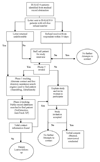Timing is everything: methodologic issues locating and recruiting medically underserved women for abnormal mammography follow-up research
- PMID: 18289943
- PMCID: PMC2483696
- DOI: 10.1016/j.cct.2008.01.003
Timing is everything: methodologic issues locating and recruiting medically underserved women for abnormal mammography follow-up research
Abstract
Objectives: Recruiting underserved women in breast cancer research studies remains a significant challenge. We present our experience attempting to locate and recruit minority and medically underserved women identified in a Nashville, Tennessee public hospital for a mammography follow-up study.
Study design: The study design was a retrospective hospital-based case-control study.
Methods: We identified 227 women (88 African-American, 65 Caucasian, 36 other minority, 38 race undocumented in the medical record) who had undergone screening mammography and received an abnormal result during 2003-2004. Of the 227 women identified, 159 women were successfully located with implementation of a tracking protocol and more rigorous attempts to locate the women using online directory assistance and public record search engines. Women eligible for the study were invited to participate in a telephone research survey. Study completion was defined as fully finishing the telephone survey.
Results: An average of 4.6 telephone calls (range 1-19) and 2.7 months (range 1-490 days) were required to reach the 159 women contacted. Within three contact attempts, more cases were located than controls (61% cases vs. 49% controls, p=0.03). African-American women cases were four times likely to be recruited than African-American controls, (OR, 4.07; 95% CI, 1.59-10.30) (p=0.003). After 3 months of effort, we located 67% of African-American women, 63% of Caucasian women, and 56% of other minorities. Ultimately, after a maximum of 12 attempts to contact women, 77% of African-American women and 71% of Caucasian women were eventually found. Of these, 59% of African-American women, 69% Caucasian women, and 50% other minorities were located and completed the study survey for an overall response rate of 59%, 71%, and 47% respectively.
Conclusions: Data collection and study recruitment efforts were more challenging in racial and ethnic minorities. Continuing attempts to contact women may increase minority group study participation but does not guarantee retention or study completion.
Figures
References
-
- Rothman KJ, Greenland S. Types of epidemiologic studies. In: Rothman KJ, Greenland S, editors. Modern Epidemiology. 2nd ed. Philadelphia, Pa: Lippincott, Williams and Wilkins; 1998.
-
- Green BL, Partridge EE, Fouad MN, et al. African-American attitudes regarding cancer clinical trials and research studies: results from focus groups methodology. Ethn Dis. 2000;10(1):76–86. - PubMed
-
- Gooden KM, Carter-Edwards L, Hoyo C, et al. Perceptions of participation in an observational epidemiologic study of cancer among African Americans. Ethn Dis. 2005;15:68–75. - PubMed
-
- Khaliq K, Gross M, Thyagarajan B, et al. What motivates minorities to participate in research? Minn Med. 2003;86:39–42. - PubMed
-
- Shavers VL, Lynch CF, Burmeister LF. Racial differences in factors that influence the willingness to participate in medical research studies. Ann Epidemiol. 2002;12:248–256. - PubMed
Publication types
MeSH terms
Grants and funding
LinkOut - more resources
Full Text Sources
Medical


